Market Size of Cardiac Resynchronization Therapy (CRT) Industry

| Study Period | 2019 - 2029 |
| Base Year For Estimation | 2023 |
| CAGR | 5.80 % |
| Fastest Growing Market | Asia Pacific |
| Largest Market | North America |
| Market Concentration | Medium |
Major Players
*Disclaimer: Major Players sorted in no particular order |
Need a report that reflects how COVID-19 has impacted this market and its growth?
Cardiac Resynchronization Therapy Market Analysis
The cardiac resynchronization therapy (CRT) market is poised to grow at a CAGR of 5.8% by the forecast period.
COVID-19 had a substantial influence on the cardiac resynchronization therapy market growth as cardiac consultations and treatments got delayed due to the lockdown. For instance, according to the research study published in May 2021 in PubMed, during the COVID-19 pandemic, cardiac procedural activity in England decreased dramatically, with a deficit of about 45,000 procedures, with no increase in the risk of mortality for most cardiac procedures conducted during the pandemic. This study showed the disrupting impact of COVID-19 on cardiology services. However, the market is predicted to expand in the coming years due to the extensive post-pandemic cardiac problems coupled with other cardiovascular complications that demand cardiac resynchronization therapy.
The major factors for the growth of the cardiac resynchronization therapy (CRT) market include the rising burden of heart failure and cardiac disorders and an increase in the geriatric population and a rising sedentary lifestyle among the population. The global population is aging rapidly, owing to reduced birth rates and increasing life expectancy. According to a report by the United Nation Economic and Social Commission for Asia and the Pacific (ESCAP), the geriatric population in the Asia-Pacific region was around 671.1 million in 2021, accounting for more than half of the world's total elderly population. It is estimated that, by 2050, Asia-Pacific is likely to account for almost two-thirds of the world's geriatric population. The rise in the geriatric population is one of the major reasons behind the increase in the cases of cardiovascular and heart failure. As the geriatric population rises, the demand for cardiac resynchronization therapy increases and thereby boosting the market growth over the forecast period.
Furthermore, as per the Centers for Disease Control and Prevention article titled published in July 2022 stated that coronary heart disease is the most common type of heart disease, and around 20.1 million adults aged 20 and older have coronary artery disease (approximately 7.2%). Thus, the high burden of coronary artery disease is driving the growth of the market. Furthermore, according to the World Heart Federation update published in 2022, stated that cardiovascular disease, including heart disease and stroke, is the most common non-communicable disease globally. Diabetes, overweight or obesity, an unhealthy diet, physical inactivity, and excessive alcohol use were the main causes of heart disease. As a result of the increasing frequency of heart illnesses worldwide, people who are affected by them are increasingly adopting cardiac resynchronization therapy worldwide.
Moreover, strategic acquisitions, collaborations, and funding are anticipated to drive market growth. For instance, in October 2022, Virginia Commonwealth University's School of Medicine received funding worth USD 31 million, for a multi-institutional study focused on evaluating a new method for pacing the heart in people with heart failure and conduction system disease. The funding was awarded by the Patient-Centered Outcomes Research Institute.
Thus, due to the rise in the burden of heart failure and cardiac disorders and an increase in the geriatric population, and a rising sedentary lifestyle among the population, the studied market is anticipated to witness significant growth over the forecast period. However, stringent regulatory frameworks restrain the market growth.
